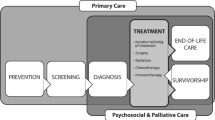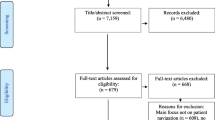Abstract
Patient navigation is an evidence-based intervention involving trained healthcare workers who assist patients in assessing and mitigating personal and environmental factors to promote healthy behaviors. The purpose of this research is to systematically assess the efficacy of patient navigation and similar programs to improve diagnosis and treatment of diseases affecting medically underserved populations. A systematic review was performed by searching PubMed, MEDLINE, PsychINFO, and CINAHL to identify potential studies. Eligible studies were those containing original peer-reviewed research reports in English on patient navigation, community health workers, vulnerable and underserved populations, and healthcare disparity. Specific outcomes regarding patient navigator including the effect of the intervention on definitive diagnosis and effect on initiation of treatment were extracted from each study. The search produced 1428 articles, and 16 were included for review. All studies involved patient navigation in the field of oncology in underserved populations. Timing of initial contact with a patient navigator after diagnostic or screening testing is correlated to the effectiveness of the navigator intervention. The majority of the studies reported significantly shorter time intervals to diagnosis and to treatment with patient navigation. Patient navigation expedites oncologic diagnosis and treatment of patients in underserved populations. This intervention is more efficacious when utilized shortly after screening or diagnostic testing.

Similar content being viewed by others
References
Martin LR, Williams SL, Haskard KB, DiMatteo MR (2005) The challenge of patient adherence. Ther Clin Risk Manag 1(3):189–199
Ferrante JM, Chen P, Kim S (2008) The effect of patient navigation on time to diagnosis, anxiety, and satisfaction in urban minority women with abnormal mammograms: a randomized controlled trial. Journal of Urban Health: Bulletin of the New York Academy of Medicine 85(1):114–124. doi:10.1007/s11524-007-9228-9
Battaglia TA, Bak S, Heeren T et al (2012) Boston Patient Navigation Research Program: the impact of navigation on time to diagnostic resolution after abnormal cancer screening. Cancer Epidemiol Biomark Prev 21(10):1645–1654. doi:10.1158/1055- 9965.EPI-12-0532
Freeman HP, Rodriguez RL (2011) The history and principles of patient navigation. Cancer 117(15 0):3539–3542. doi:10.1002/cncr.26262
Moher D, Liberati A, Tetzlaff J, Altman D (2009) Preferred Reporting Items for Systematic Reviews and Meta-analyses: the PRISMA statement. Br Med J 338:b2535
Oxford Centre for Evidence-based Medicine—levels of evidence (2009). Centre for Evidence-Based Medicine. Retrieved May 4, 2016
Percac-Lima S, Ashburner JM, McCarthy AM, Piawah S, Atlas SJ (2015) Patient navigation to improve follow-up of abnormal mammograms among disadvantaged women. J Women’s Health 24(2):138–143. doi:10.1089/jwh.2014.4954
Lee J, Fulp W, Wells KJ, Meade CD, Calcano E, Roetzheim R (2014) Effect of patient navigation on time to diagnostic resolution among patients with colorectal cancer-related abnormalities. J Canc Educ 29:144–150. doi:10.1007/s13187-013-0561-2
Freund KM, Battaglia TA, Calhoun E et al (2014) Impact of patient navigation on timely cancer care: the Patient Navigation Research Program. JNCI 106(6). doi:10.1093/jnci/dju115
Bensink ME, Ramsey SD, Battaglia T et al (2014) Costs and outcomes evaluation of patient navigation after abnormal cancer screening. Cancer:570–578. doi:10.1002/cncr.28438
Lee J, Fulp W, Wells KJ, Meade CD, Calcano E, Roetzheim R (2013) Patient navigation and time to diagnostic resolution: results for a cluster randomized trial evaluating the efficacy of patient navigation among patients with breast cancer screening abnormalities, Tampa, FL. PLoS One 8(9):e74542. doi:10.1371/journal.pone.0074542
Dudley DJ, Drake J, Quinlan J et al (2012) Beneficial effects of a combined navigator/promotora approach for Hispanic women diagnosed with breast abnormalities. Cancer Epidemiol Biomark Prev 21(10):1639–1644. doi:10.1158/1055- 9965.EPI-12-0538
Markossian TW, Darnell JS, Calhoun EA (2012) Follow-up and timeliness after an abnormal cancer screening among underserved, urban women in a patient navigation program. Cancer Epidemiol Biomark Prev 21(10):1691–1700. doi:10.1158/1055- 9965.EPI-12-0535
Paskett E, Katz ML, Douglas MP et al (2012) The ohio Patient Navigation Research Program (OPNRP): does the American Cancer Society patient navigation model improve time to resolution among patients with abnormal screening tests? Cancer Epidemiol Biomark Prev 21(10):1620–1628. doi:10.1158/1055-9965.EPI-12-0523
Raich PC, Whitley EM, Thorland W, Valverde P, Fairclough D (2012) Patient navigation improves cancer diagnostic resolution: an individually randomized clinical trial in an underserved population. Cancer Epidemiol Biomark Prev 21(10):1629–1638. doi:10.1158/1055-9965.EPI-12-0513
Wells KJ, Lee J, Calcano E et al (2012) A cluster randomized trial evaluating the efficacy of patient navigation in improving quality of diagnostic care for patients with breast or colorectal cancer abnormalities. Cancer Epidemiol Biomark Prev 21(10):1664–1672. doi:10.1158/1055-9965.EPI-12-0448
Ell K, Vourlekis B, Lee P, Xie B (2007) Patient navigation and case management following an abnormal mammogram: a randomized clinical trial. Prev Med 44:26–33. doi:10.1016/j.ypmed.2006.08.001
Ell K, Vourlekis B, Muderspach L et al (2002) Abnormal cervical screen follow-up among low-income Latinas: project safe. J Women’s Health Gend-Based Med 11(7):639–651
Ramirez A, Perez-Stable E, Penedo F et al (2014) Reducing time-to-treatment in underserved Latinas with breast cancer. Cancer:752–760. doi:10.1002/cncr.28450
Ell K, Padgett D, Vourlekis B et al (2002) Abnormal mammogram follow-up: a pilot study in women with low income. Cancer Pract 10(3):130–138
Huo Q, Cai C, Zhang Y et al (2015) Delay in diagnosis and treatment of symptomatic breast cancer in China. Ann Surg Oncol 22(3):883–888. doi:10.1245/s10434-014-4076-9
Redaniel MT, Martin RM, Blazeby JM, Wade J, Jeffreys M (2014) The association of time between diagnosis and major resection with poorer colorectal cancer survival: a retrospective cohort study. BMC Cancer 14:642. doi:10.1186/1471-2407-14-642
Dolly D, Mihai A, Rimel BJ et al (2016) A delay from diagnosis to treatment is associated with decreased overall survival for patients with endometrial cancer. Front Oncol 12(6):31. doi:10.3389/fonc.2016.00031
Gilbert JE, Green E, Lankshear S et al (2011) Nurses as patient navigators in cancer diagnosis: review, consultation and model design. Eur J Cancer Care 20:228–236
Acknowledgements
This work was supported by the National Center for Advancing Translational Sciences and the University of Kentucky Center for Clinical and Translational Science (UL1TR000117) (TS) and the National Institute of Deafness and Other Communication Disorders (1K23DC014074) (MLB). MLB is a member of the Surgical Advisory Board of Med El Corporation.
Author information
Authors and Affiliations
Corresponding author
Ethics declarations
Conflict of Interest
The authors declare that they have no conflicts of interest.
Rights and permissions
About this article
Cite this article
Bush, M.L., Kaufman, M.R. & Shackleford, T. Adherence in the Cancer Care Setting: a Systematic Review of Patient Navigation to Traverse Barriers. J Canc Educ 33, 1222–1229 (2018). https://doi.org/10.1007/s13187-017-1235-2
Published:
Issue Date:
DOI: https://doi.org/10.1007/s13187-017-1235-2




